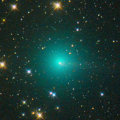
|
Now it is so bright as 8.2 mag (May 6, Marco Goiato). It was origianlly predicted to be 15 mag, but actually, it is much brighter than expected now. It looks very large with a diameter of 12 arcmin (May 3, Michael Jager). The condition is excellent in the Southern Hemisphere, and it keeps visible with binoculars until summer. In the Northern Hemisphere, it is only observable from early June to mid August in the evening low sky.
Date(TT) R.A. (2000) Decl. Delta r Elong. m1 Best Time(A, h)
May 9 20 1.47 -63 17.0 1.257 1.888 112 8.1 4:56 ( 0, 62)
May 16 18 48.55 -66 57.8 1.111 1.863 122 7.6 3:18 ( 0, 58)
|
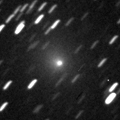
|
It is already so bright as 8.9 mag (May 2, Seiichi Yoshida). It will reach to 8 mag in June. Now it is moving southwards very fast. In the Northern Hemisphere, it is getting lower very rapidly, and it will never be observable again after June. In the Southern Hemisphere, it keeps observable for a long time after this in the evening sky.
Date(TT) R.A. (2000) Decl. Delta r Elong. m1 Best Time(A, h)
May 9 6 25.57 22 44.1 1.773 1.321 47 8.8 18:36 (133, 16)
May 16 6 41.27 18 45.4 1.781 1.280 44 8.6 18:32 (129, 17)
|

|
It is already so bright as 8.9 mag (May 2, Juan Jose Gonzalez). It will be observable at 8-10 mag in good condition for a long time until late autumn.
Date(TT) R.A. (2000) Decl. Delta r Elong. m1 Best Time(A, h)
May 9 22 51.76 34 42.4 3.590 3.178 58 9.1 5:15 (211, 12)
May 16 22 50.31 34 57.2 3.489 3.166 63 9.0 5:20 (204, 15)
|

|
Now it is bright as 9.2 mag (May 2, Juan Jose Gonzalez). It keeps 9-10 mag for a while until July. In the Northern Hemisphere, it is getting lower in the evening sky, and will be too low to observe soon. But it will appear in the morning sky again at 12 mag in late August, then it will be fading slowly in the low sky. In the Southern Hemisphere, it is not observable until August. But it keeps observable in good condition for a long time after August.
Date(TT) R.A. (2000) Decl. Delta r Elong. m1 Best Time(A, h)
May 9 4 2.03 50 29.4 1.959 1.275 35 9.0 18:36 (136,-24)
May 16 4 35.97 47 6.7 2.037 1.281 31 9.1 18:32 (134,-20)
|
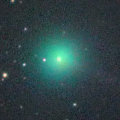
|
Now it is bright as 8.7 mag (May 6, Marco Goiato). It keeps 9-10 mag until June. In the Southern Hemisphere, it keeps observable in a good condition for a long time. In the Northern Hemisphere, it will never be observable again.
Date(TT) R.A. (2000) Decl. Delta r Elong. m1 Best Time(A, h)
May 9 23 42.44 -22 43.5 1.221 1.186 63 9.2 5:15 (268, 45)
May 16 0 9.15 -30 31.7 1.133 1.224 69 9.1 5:20 (277, 49)
|

|
Now it is 9.0 mag, already so bright (May 2, Juan Jose Gonzalez). It will be bright at 9-10 mag for a long time until autumn.
Date(TT) R.A. (2000) Decl. Delta r Elong. m1 Best Time(A, h)
May 9 20 58.48 -13 59.8 1.133 1.586 95 9.8 5:15 (203, 68)
May 16 21 15.77 -13 4.9 1.085 1.580 97 9.7 5:20 (193, 68)
|
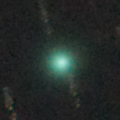
|
It brightened rapidly, and it reached up to 7.5 mag on Apr. 5 (Juan Jose Gonzalez). Now it is appearing in the morning sky again. It is still very bright as 8.8 mag now (May 2, Juan Jose Gonzalez). It will be getting higher gradually after this, and it keeps observable until it has gone away. The comet will fade out rapidly, but it will be visible visually at 13 mag still in late May.
Date(TT) R.A. (2000) Decl. Delta r Elong. m1 Best Time(A, h)
May 9 0 34.21 30 58.5 1.467 0.889 36 10.6 5:15 (230, 1)
May 16 0 19.05 30 59.9 1.411 0.994 44 11.5 5:20 (222, 8)
|

|
It passed near by the earth in late February, and it reached up to 4.9 mag (Feb. 23, Juan Jose Gonzalez). The coma extended up to 20 arcmin, and the anti-tail was clearly visible. Now it is fading rapidly. It has already faded down to 10.5 mag (Apr. 26, Marco Goiato). Because moving along the retrograde orbit, it will be lower rapidly in the evening sky. It will be too low to observe at 12 mag in late May.
Date(TT) R.A. (2000) Decl. Delta r Elong. m1 Best Time(A, h)
May 9 6 37.03 22 20.7 2.616 2.117 50 11.2 18:36 (135, 17)
May 16 6 39.27 22 18.0 2.806 2.193 43 11.5 18:32 (131, 14)
|

|
It has already brightened up to 10.7 mag (Apr. 26, Marco Goiato). It keeps as bright as 10-11 mag for a long time untio 2010 spring. It is not observable in the Northern Hemisphere now. But it will appear in the morning sky in early October, then it keeps observable at 10 mag in good condition for a long time. In the Southern Hemisphere, it is getting lower rapidly in the evening sky, and will be too low to observe in July.
Date(TT) R.A. (2000) Decl. Delta r Elong. m1 Best Time(A, h)
May 9 6 29.14 -15 54.6 3.176 2.820 60 11.3 18:36 (101, 42)
May 16 6 39.75 -13 54.6 3.194 2.775 56 11.3 18:32 (101, 39)
|
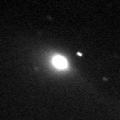
|
It has brightened very rapidly, faster than expected. Now it is so bright as 9.6 mag (Apr. 20, Juan Jose Gonzalez). It will be fading gradually after this. It will be too low to observe in the evening at 13 mag in late June.
Date(TT) R.A. (2000) Decl. Delta r Elong. m1 Best Time(A, h)
May 9 6 4.37 28 9.3 2.075 1.500 42 11.5 18:36 (133, 8)
May 16 6 30.04 28 5.7 2.146 1.546 41 11.7 18:32 (134, 9)
|
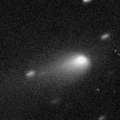
|
Now it is very bright as 11.4 mag (Apr. 29, Marco Goiato). It keeps observable in good condition until May, then it keeps observable until July when it becomes too low in the evening sky, around 12-13 mag for a long time.
Date(TT) R.A. (2000) Decl. Delta r Elong. m1 Best Time(A, h)
May 9 9 43.35 16 0.7 1.916 2.232 94 12.7 18:36 (179, 39)
May 16 9 51.39 15 5.0 1.983 2.222 89 12.8 18:32 (175, 40)
|

|
It brightened up to 9.8 mag in December and January (Dec. 28, Juan Jose Gonzalez). Now it is fading, but still bright as 12.4 mag (Apr. 28, Martin Lehky). It will be too low to observe in June. However, it will be observable in good condition again in winter at 15 mag. Then it may be still visible visually.
Date(TT) R.A. (2000) Decl. Delta r Elong. m1 Best Time(A, h)
May 9 7 25.01 29 56.5 3.876 3.489 60 12.9 18:36 (149, 17)
May 16 7 33.75 28 57.6 4.010 3.540 55 13.1 18:32 (145, 16)
|

|
It brightened up to 11.5 mag in last summer (Aug. 4, Marco Goiato). Although it is not observable in the Northern Hemisphere, it keeps observable in good condition for a long time in the Southern Hemisphere. However, no visual observations have been reported since last summer. Recent CCD observations suggest that it is still visible visually around 12-13 mag.
Date(TT) R.A. (2000) Decl. Delta r Elong. m1 Best Time(A, h)
May 9 4 37.32 -48 42.8 3.420 3.204 69 13.2 18:36 ( 51, 34)
May 16 4 49.53 -46 45.9 3.482 3.244 68 13.3 18:32 ( 52, 31)
|

|
It brightened much faster than expected, and reached up to 8.4 mag (Jan. 30, Juan Jose Gonzalez). It was very large and visible through binoculars. Now it is fading rapidly. But it is still bright as 12.0 mag (Apr. 28, Martin Lehky). It is getting lower gradually in the evening sky, and will be too low to observe in July.
Date(TT) R.A. (2000) Decl. Delta r Elong. m1 Best Time(A, h)
May 9 8 49.65 13 5.4 1.648 1.822 82 13.4 18:36 (162, 40)
May 16 9 6.34 12 6.7 1.749 1.867 80 13.8 18:32 (160, 41)
|

|
The condition of this return is bad, and it has not been observed yet. It will appear in the morning low sky at 13.5 mag in June. Then it will be getting higher gradually while fading slowly.
Date(TT) R.A. (2000) Decl. Delta r Elong. m1 Best Time(A, h)
May 9 1 25.29 14 33.1 2.310 1.445 23 13.7 5:15 (250, 3)
May 16 1 48.19 16 52.2 2.278 1.422 24 13.6 5:20 (247, 3)
|

|
Now it is 12.3 mag, still visible visually (Apr. 28, Martin Lehky). It had been visible visually as bright as 10-11 mag for half a year since 2008 September until 2009 March. However, it has been faint as 12 mag since April.
Date(TT) R.A. (2000) Decl. Delta r Elong. m1 Best Time(A, h)
May 9 7 52.36 22 12.8 6.443 6.128 67 14.0 18:36 (151, 27)
May 16 7 55.91 21 57.9 6.546 6.130 61 14.0 18:32 (146, 25)
|

|
It reached to 10.9 mag in May (May 11, Marco Goiato). It is fading slowly. Now it is 14.0 mag (Apr. 28, Martin Lehky), still visible visually. It keeps bright as 13-14 mag for a long time after this until summer.
Date(TT) R.A. (2000) Decl. Delta r Elong. m1 Best Time(A, h)
May 9 16 37.88 34 37.3 3.485 4.128 123 14.1 1:31 (180, 20)
May 16 16 33.53 35 39.2 3.535 4.177 123 14.2 1:00 (180, 19)
|

|
Now it is 12.9 mag and visible visually (May 2, Juan Jose Gonzalez). It will brighten up to 12-13 mag in 2010 summer. In 2009, it keeps observable in good condition until summer.
Date(TT) R.A. (2000) Decl. Delta r Elong. m1 Best Time(A, h)
May 9 11 52.43 13 29.1 2.312 2.992 123 14.3 20:43 (180, 42)
May 16 11 51.58 12 59.6 2.370 2.971 117 14.3 20:14 (180, 42)
|
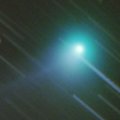
|
It reached to 6.3 mag in September in the southern sky (Sept. 4, Marco Goiato). Now it is fading. Although it has already become fainter than 16 mag by CCD observations, it seems to be still visible visually around 14 mag.It keeps observable in the northern sky while fading gradually. In the Southern Hemisphere, it will never be observable again.
Date(TT) R.A. (2000) Decl. Delta r Elong. m1 Best Time(A, h)
May 9 23 42.48 73 38.3 3.628 3.291 62 14.6 5:15 (194,-24)
May 16 0 5.95 75 33.5 3.715 3.368 62 14.8 5:20 (192,-25)
|

|
Now it is 15.5 mag (Apr. 19, Ken-ichi Kadota). It will be brightening rapidly after this, and will be 10 mag in autumn. It keeps observable for a long time until 2010 February. But in the Northern Hemisphere, it will be lower than 20 degree after July when it becomes about 13 mag, then it keeps very low all through the brightest time. It locates a bit higher in the Southern Hemisphere.
Date(TT) R.A. (2000) Decl. Delta r Elong. m1 Best Time(A, h)
May 9 12 26.74 1 23.9 1.234 2.089 137 15.0 21:17 (180, 54)
May 16 12 22.76 1 25.0 1.246 2.043 129 14.8 20:45 (180, 54)
|

|
Now it is 13.7 mag (Apr. 21, Juan Jose Gonzalez). It had been bright and visible visually around 13 mag from spring to autumn in 2008. It will be visible visually at 14 mag again until summer.
Date(TT) R.A. (2000) Decl. Delta r Elong. m1 Best Time(A, h)
May 9 13 53.90 38 0.5 5.966 6.561 122 14.9 22:43 (180, 17)
May 16 13 46.21 38 7.5 6.055 6.587 117 15.0 22:08 (180, 17)
|
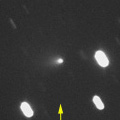
|
Now it is visible visually at 13.6 mag (Apr. 23, Mitsunori Tsumura). It will keep 14-15 mag for a while. But it will be getting lower rapidly after this, and will be too low to observe in July.
Date(TT) R.A. (2000) Decl. Delta r Elong. m1 Best Time(A, h)
May 9 11 30.47 4 55.0 1.639 2.345 122 15.0 20:21 (180, 50)
May 16 11 30.11 3 30.6 1.703 2.338 116 15.0 19:53 (180, 52)
|

|
It brightened up to 12.7 mag in 2008 spring (Apr. 12, Marco Goiato). But it faded down to 14.9 mag in July (July 22, Mitsunori Tsumura). In the Southern Hemisphere, it will be observable in good condition after this. It will never be observable again in the Northern Hemisphere.
Date(TT) R.A. (2000) Decl. Delta r Elong. m1 Best Time(A, h)
May 9 20 17.87 -52 6.0 3.435 3.905 110 15.3 5:11 ( 0, 73)
May 16 20 20.22 -52 48.8 3.402 3.948 115 15.3 4:46 ( 0, 72)
|
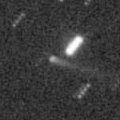
|
It passed near by the earth in April. It brightened up to 14.3 mag and became visible visually (Apr. 22, Alan Hale). It moves southward very rapidly, and it will locate very low after late May in the Northern Hemisphere. The ephemeris says that it will be fading after this, and will be fainter than 18 mag in August. But actually, it has not started fading after the perihelion passage. It is still bright as 13.8 mag (May 2, Juan Jose Gonzalez).
Date(TT) R.A. (2000) Decl. Delta r Elong. m1 Best Time(A, h)
May 9 22 26.24 -11 48.6 0.346 0.975 74 15.7 5:15 (238, 54)
May 16 22 43.69 -18 8.6 0.382 1.015 79 15.9 5:20 (242, 60)
|

|
Now it is 14.5 mag and visible visually (Mar. 22, Juan Jose Gonzalez). It will be getting lower in the evening sky after this, and will be too low to observe in July.
Date(TT) R.A. (2000) Decl. Delta r Elong. m1 Best Time(A, h)
May 9 9 17.39 22 38.7 3.487 3.569 86 15.8 18:36 (172, 32)
May 16 9 22.28 22 7.5 3.583 3.567 80 15.8 18:32 (167, 32)
|
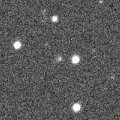
|
Now it is 16.3 mag (Mar. 20, H. Sato). It will brighten up to 15 mag in 2009 and 2010, and will be observable for a long time in good condition.
Date(TT) R.A. (2000) Decl. Delta r Elong. m1 Best Time(A, h)
May 9 21 40.62 39 28.2 3.286 3.127 72 16.0 5:15 (195, 13)
May 16 21 35.11 42 12.7 3.170 3.096 76 15.9 5:20 (188, 12)
|

|
Now it is 17.7 mag (Apr. 8, Yasukazu Ikari). It will brighten rapidly after this, and it is expected to be observable at 10-11 mag in a good condition for a long time from summer to winter.
Date(TT) R.A. (2000) Decl. Delta r Elong. m1 Best Time(A, h)
May 9 21 28.61 -10 28.7 1.679 1.917 87 16.3 5:15 (215, 61)
May 16 21 44.26 -9 43.3 1.559 1.860 90 16.0 5:20 (207, 62)
|

|
It is expected to reach up to 12 mag in 2012, and to be observable visually at 12-13 mag for a long time from 2011 to 2013. In 2009, it is observable in good condition at 16 mag from summer to autumn. In the Northern Hemisphere, the comet will be low around its brightest seasons.
Date(TT) R.A. (2000) Decl. Delta r Elong. m1 Best Time(A, h)
May 9 22 58.17 5 27.2 9.638 9.192 61 16.6 5:15 (230, 35)
May 16 22 58.28 5 38.3 9.492 9.155 67 16.5 5:20 (222, 40)
|
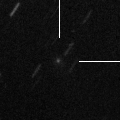
|
It will be fading after this, and will be fainter than 18 mag in July.
Date(TT) R.A. (2000) Decl. Delta r Elong. m1 Best Time(A, h)
May 9 14 6.23 -14 22.2 2.040 3.029 165 16.6 22:56 (180, 69)
May 16 13 58.75 -11 16.5 2.125 3.078 156 16.7 22:21 (180, 66)
|
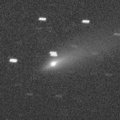
|
It reached up to 9.6 mag in summer (Aug. 2, Juan Jose Gonzalez). Now it is fading. It has already faded down to 16.4 mag (Apr. 4, Ken-ichi Kadota). It keeps observable in good condition until June when it becomes fainter than 18 mag.
Date(TT) R.A. (2000) Decl. Delta r Elong. m1 Best Time(A, h)
May 9 12 31.93 35 45.7 2.508 3.086 115 16.7 21:22 (180, 19)
May 16 12 29.35 34 24.8 2.619 3.131 111 16.9 20:52 (180, 21)
|
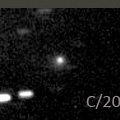
|
It reached up to 16.4 mag in spring (Mar. 14, Ken-ichi Kadota). It will be fading after this, and will be fainter than 18 mag in July.
Date(TT) R.A. (2000) Decl. Delta r Elong. m1 Best Time(A, h)
May 9 14 46.29 35 55.9 2.521 3.226 126 16.8 23:34 (180, 19)
May 16 14 25.90 34 49.7 2.580 3.254 123 16.9 22:47 (180, 20)
|
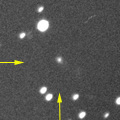
|
Now it is 16.6 mag (Apr. 15, Ken-ichi Kadota). It will reach to 15 mag in 2010. It keeps observable for a long time after this in the Northern Hemisphere.
Date(TT) R.A. (2000) Decl. Delta r Elong. m1 Best Time(A, h)
May 9 15 26.12 2 58.1 5.080 6.033 158 16.8 0:20 (180, 52)
May 16 15 22.86 3 48.0 5.054 5.998 157 16.8 23:45 (180, 51)
|

|
It has already faded down to 17.1 mag (Apr. 28, Yasukazu Ikari). It will be fainter than 18 mag in July.
Date(TT) R.A. (2000) Decl. Delta r Elong. m1 Best Time(A, h)
May 9 11 9.97 1 16.5 3.675 4.264 119 17.1 20:00 (180, 54)
May 16 11 9.57 2 27.4 3.831 4.317 112 17.2 19:32 (180, 53)
|
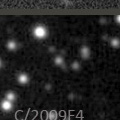
|
It will reach up to 14-15 mag from 2011 to 2012. Now it is 17 mag and locates low in the south.
Date(TT) R.A. (2000) Decl. Delta r Elong. m1 Best Time(A, h)
May 9 15 25.93 -24 37.6 7.701 8.699 171 17.3 0:20 (180, 80)
May 16 15 22.06 -24 45.3 7.658 8.664 173 17.3 23:44 (180, 80)
|

|
Peculiar asteroid moving along a cometary orbit. It will fade out very rapidly after May.
Date(TT) R.A. (2000) Decl. Delta r Elong. m1 Best Time(A, h)
May 9 13 49.90 -3 7.9 1.412 2.374 157 17.4 22:39 (180, 58)
May 16 13 45.34 -3 22.2 1.494 2.422 149 17.6 22:08 (180, 58)
|
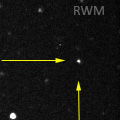
|
It reached 16.9 mag at opposition in March (Mar. 28, Ken-ichi Kadota). But it will fade out soon, and will be fainter than 18 mag in May.
Date(TT) R.A. (2000) Decl. Delta r Elong. m1 Best Time(A, h)
May 9 11 47.35 -4 10.3 1.778 2.549 130 17.8 20:38 (180, 59)
May 16 11 49.08 -3 59.9 1.840 2.545 123 17.9 20:12 (180, 59)
|

|
It was observed bright at 16.5-17 mag from late 2006 to early 2007. However, it is fading after that, although it is getting closer to the sun. It was so faint as 19.4 mag around the perihelion passage in 2008 spring (Mar. 10, Mitsunori Tsumura). Now it is extremely faint as 21.2 mag (Apr. 20, J. V. Scotti). This comet was observed so faint around the perihelion passage in the previous apparition at the discovery. It faded out before the perihelion passage again in this apparition.
Date(TT) R.A. (2000) Decl. Delta r Elong. m1 Best Time(A, h)
May 9 11 18.41 23 46.1 4.003 4.471 111 22.5 20:09 (180, 31)
May 16 11 18.97 23 19.6 4.106 4.480 105 22.6 19:42 (180, 32)
|
|
![]()
 29P/Schwassmann-Wachmann 1
29P/Schwassmann-Wachmann 1 C/2006 Q1 ( McNaught )
C/2006 Q1 ( McNaught ) 65P/Gunn
65P/Gunn C/2008 A1 ( McNaught )
C/2008 A1 ( McNaught ) 88P/Howell
88P/Howell C/2005 L3 ( McNaught )
C/2005 L3 ( McNaught ) 77P/Longmore
77P/Longmore C/2007 B2 ( Skiff )
C/2007 B2 ( Skiff ) 209P/2008 X2 ( LINEAR )
209P/2008 X2 ( LINEAR ) 74P/Smirnova-Chernykh
74P/Smirnova-Chernykh C/2008 N1 ( Holmes )
C/2008 N1 ( Holmes ) 217P/2009 F3 ( LINEAR )
217P/2009 F3 ( LINEAR ) C/2006 S3 ( LONEOS )
C/2006 S3 ( LONEOS ) C/2009 F5 ( McNaught )
C/2009 F5 ( McNaught ) 19P/Borrelly
19P/Borrelly C/2008 Q1 ( Maticic )
C/2008 Q1 ( Maticic ) C/2008 FK75 ( Lemmon-Siding Spring )
C/2008 FK75 ( Lemmon-Siding Spring ) C/2006 U6 ( Spacewatch )
C/2006 U6 ( Spacewatch ) C/2009 F4 ( McNaught )
C/2009 F4 ( McNaught ) 2001 TX16
2001 TX16 143P/Kowal-Mrkos
143P/Kowal-Mrkos 173P/2005 T1 ( Mueller 5 )
173P/2005 T1 ( Mueller 5 )![]()

































